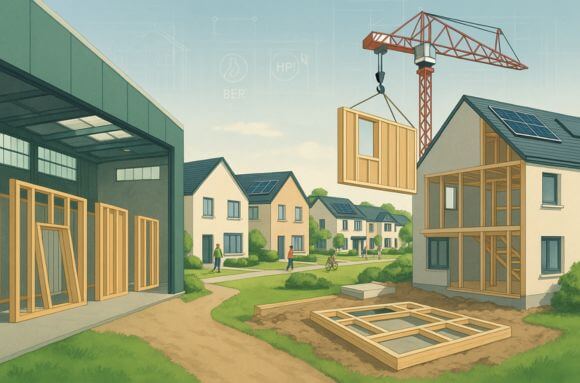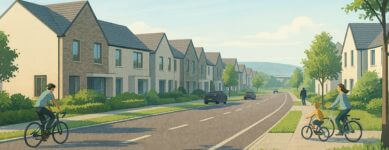Rapid population growth and ambitious climate targets encourage housing that is delivered faster, greener, and more cost‑efficiently than traditional blockwork alone can manage. Modern methods of construction (MMC) provide the toolkit for sustainability in the industry. This article defines MMC, compares the main techniques used in Ireland, and shows how Castlethorn deploys them to build high‑quality, energy‑efficient communities.
What Does MMC Mean?
Modern Methods of Construction refer to building systems that are largely manufactured off‑site, then assembled on‑site, to improve consistency, speed and sustainability across a home’s life‑cycle.
The Irish Government’s Housing for All - Innovation and Productivity strategy calls MMC “a critical enabler of accelerated housing delivery.”
Key principles include:
- Precision manufacturing – factory‑controlled conditions ensure tighter tolerances and reduce material waste.
- Pre‑fabrication & modularity – whole panels, pods or modules arrive ready‑made, shortening on‑site programme length.
- Integrated digital design – Building Information Modelling (BIM) drives co‑ordination and reduces re‑work.
Core MMC Techniques in Irish Residential Projects
There are multiple MMC techniques used to complete residential developments:
Panelised timber-frame – Factory-built wall and roof panels are fixed to pre-prepared foundations on site, bringing the structure to weather-tight stage up to 30% faster than masonry.
- Key advantages: excellent thermal performance (≈ 0.18 W/m²K U-values) and reduced on-site waste.
- Castlethorn use-case: the standard build system for Woodbrook’s A-rated homes.
Volumetric modular – Fully finished 3-D pods (bathrooms, kitchens) arrive ready-made and are craned into position while ground works continue in parallel.
- Key advantages: parallel factory-and-site activity and superior quality control.
- Castlethorn use-case: trialled on the Belarmine Phase 2 apartment blocks.
Hybrid steel–timber – A light-gauge steel core paired with timber infill panels delivers longer spans and lighter embodied carbon than full concrete.
- Key advantages: ideal for mid-rise apartments, balancing structure, fire, acoustics and sustainability.
- Castlethorn use-case: in detailed design for Woodbrook’s six-storey cost-rental blocks.
3-D concrete printing (emerging) – A robotic gantry extrudes low-carbon concrete in sequential layers, forming walls directly from the BIM model.
- Key advantages: material efficiency and freedom to create complex geometries without formwork.
- Castlethorn use-case: R&D partnership under review; no commercial deployment yet.
Why MMC Matters
1. Speed & Predictability
Factory production removes weather downtime, allowing homes to reach roof stage three to four weeks sooner than masonry equivalents—critical for investor cash‑flow.
2. Quality & Performance
CNC‑cut panels achieve tighter joints and consistent airtightness, underpinning Castlethorn’s typical A2 BER ratings.
3. Sustainability
MMC can cut embodied carbon by up to 25%, thanks to reduced concrete usage and lower waste. Off‑site factories also recycle timber off‑cuts and optimise transport loads.
4. Health & Safety
Controlled factory environments reduce high‑risk on‑site tasks such as working at height and repetitive manual block‑laying—aligning with Castlethorn’s Safety First commitment.
Regulatory Framework & Funding Supports
Ireland’s National Development Plan 2021‑2030 encourages MMC uptake. A few key points from the plan include:
- Building Regulations Part L & Part A – Timber‑frame and modular systems must meet the same structural and energy standards as traditional builds.
- NSAI Agrément Certification – Ensures off‑site systems are independently tested for Irish climate conditions.
- Home Building Finance Ireland (HBFI) Green Lending – Offers preferential rates for developments that use low‑carbon MMC and achieve BER A3 or better.
Developers must submit detailed manufacturer specifications at planning‑condition stage to satisfy local authority building control.
Castlethorn’s MMC Strategy in Practice
- Volumetric Pods at Belarmine – Bathroom pods arrive fully tiled and tested, cutting on‑site wet‑trades by 70% and slashing snag lists.
- Hybrid Systems for Height – The six‑storey blocks at Woodbrook pair light‑gage steel cores with cross‑laminated timber (CLT) floors to balance fire, acoustics and carbon metrics.
Through early supplier engagement and BIM‑driven design, Castlethorn helps mitigate programme risk while delivering homes that align with our values of quality, innovation, and sustainability. The impact for our clients and end users is also impressive:
- For Homebuyers – MMC homes perform the same—or better—than traditional builds, with lower energy bills and consistent finish quality.
- For Institutional Investors & Funds – Reduced build times can improve Internal Rate of Return (IRR), while lower embodied carbon supports ESG targets and EU Taxonomy alignment.
- For Communities – Shorter on‑site programmes mean less traffic, noise and dust during construction, enhancing local amenity.
Due‑Diligence Checklist
- Ask for NSAI Agrément certificates covering the specific panel or module system.
- Request airtightness & U‑value test data to confirm energy performance.
- Verify fire‑safety compliance (Part B) and acoustic ratings for apartments.
- Confirm manufacturer supply‑chain capacity—factory slots are booked months in advance.
Conclusion
Modern Methods of Construction are reshaping Irish house‑building, providing faster delivery, superior quality and measurable carbon savings. By integrating panelised timber‑frame, modular pods and hybrid structures across projects like Woodbrook, Castlethorn is at the forefront of sustainable, high‑performance homebuilding.
Looking for more detail? Browse our track record or contact us to discover how we can partner together on your next project.




